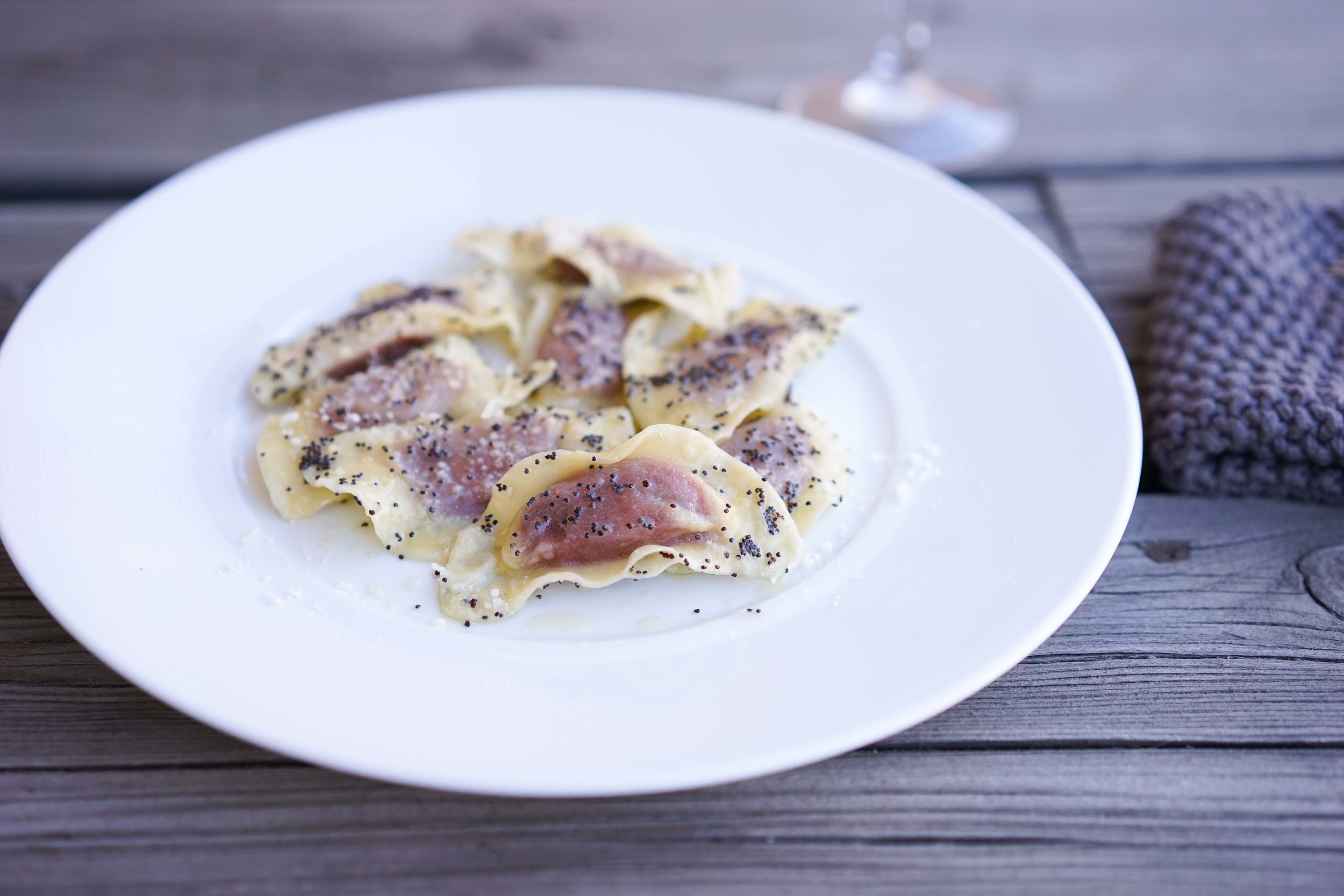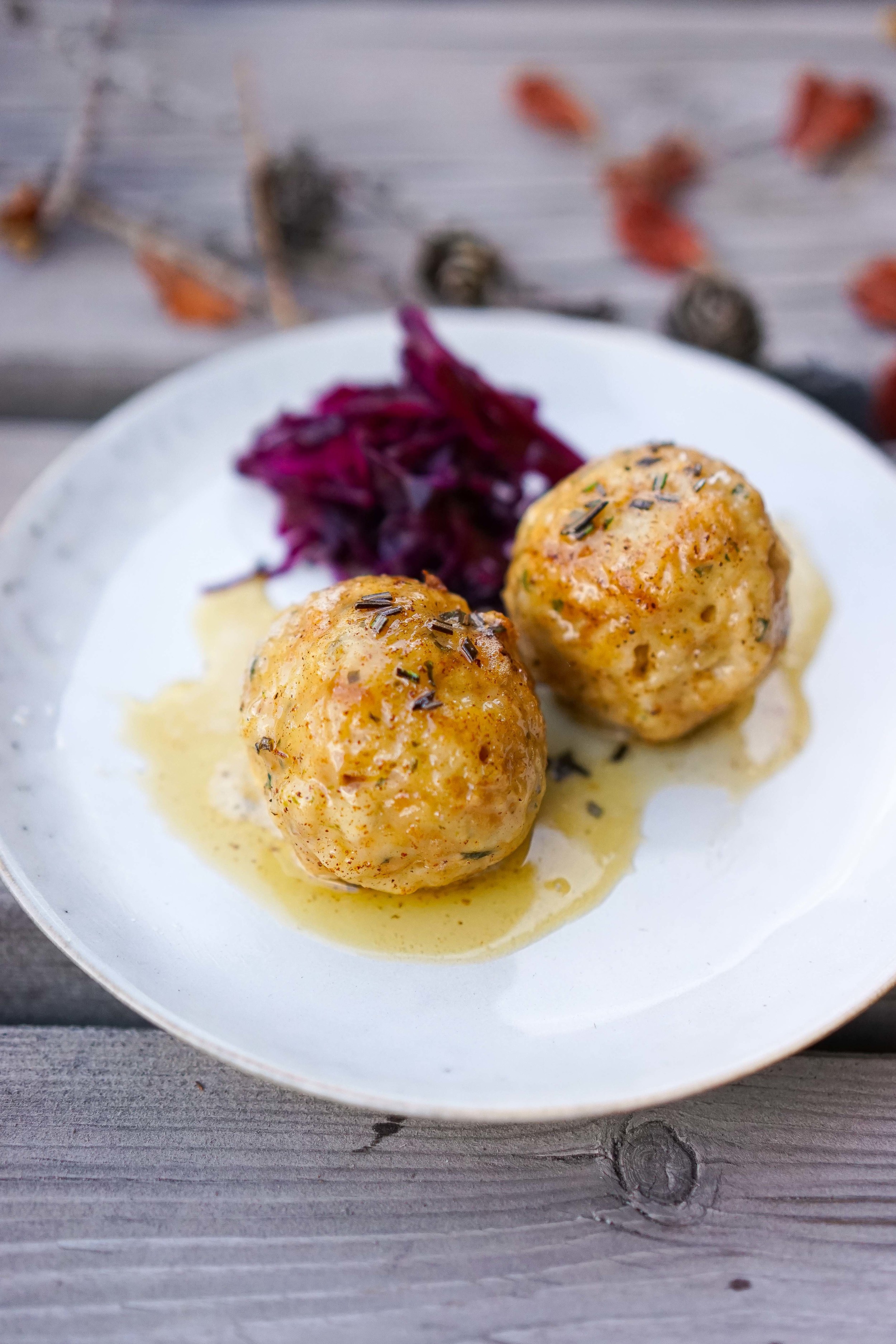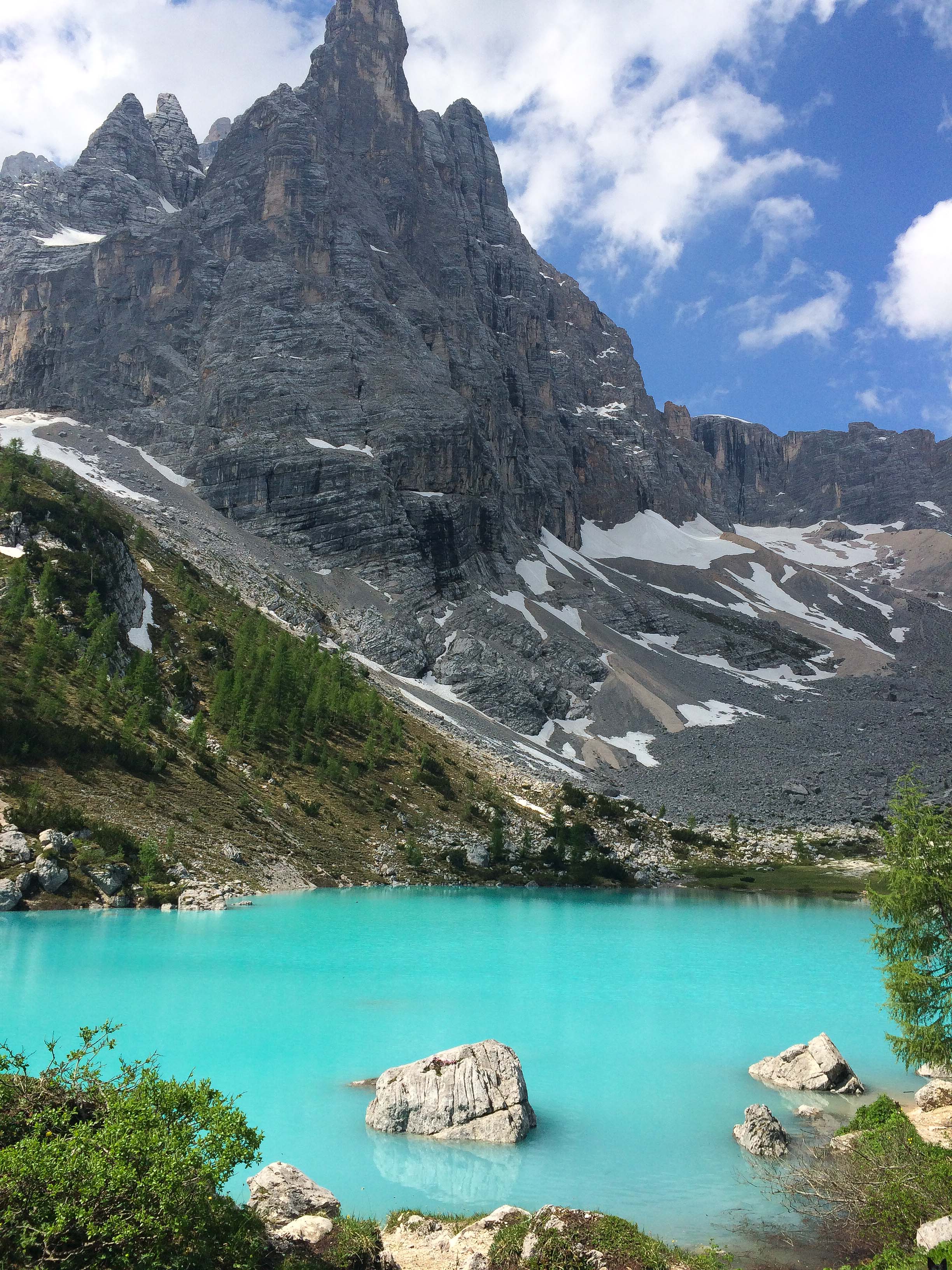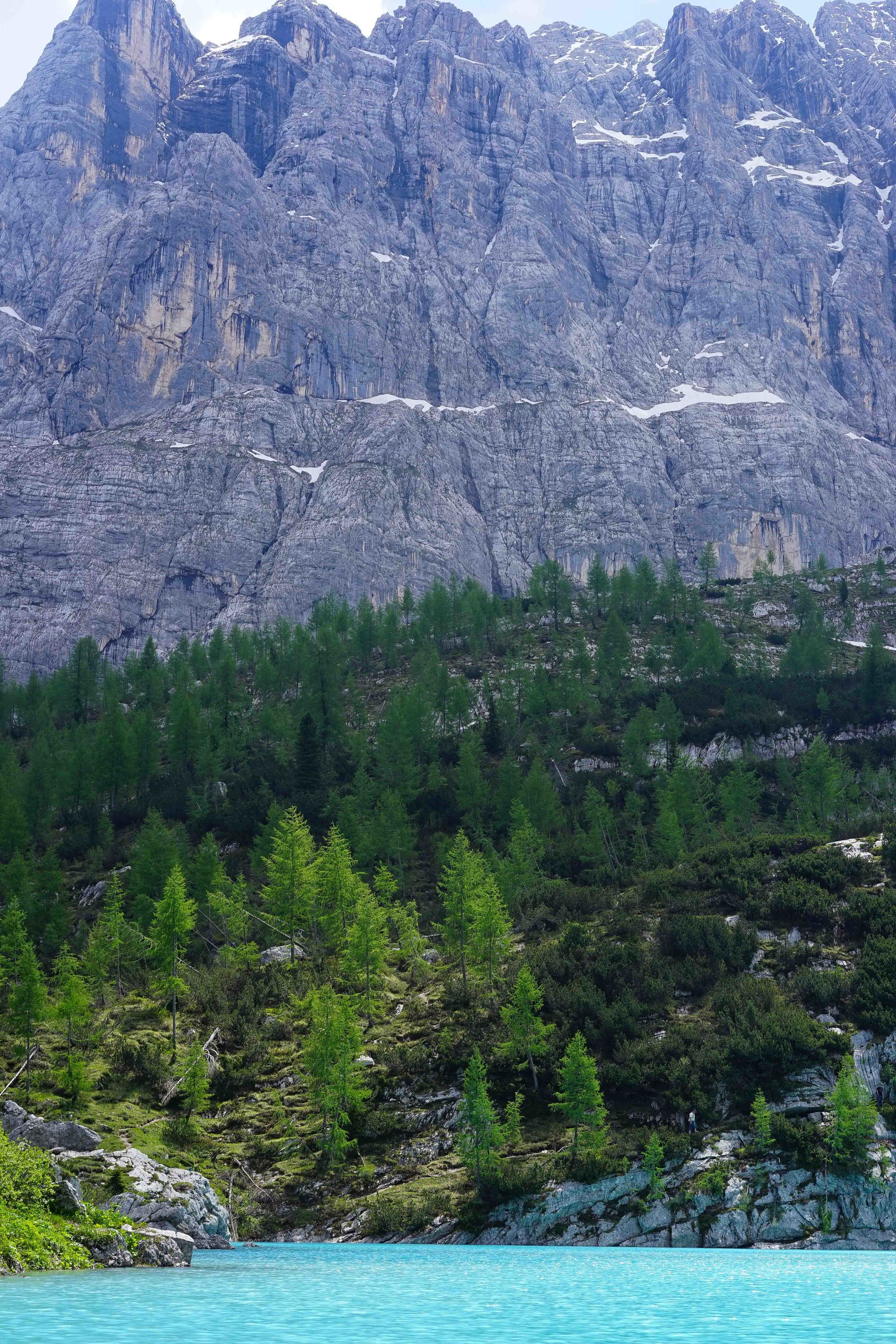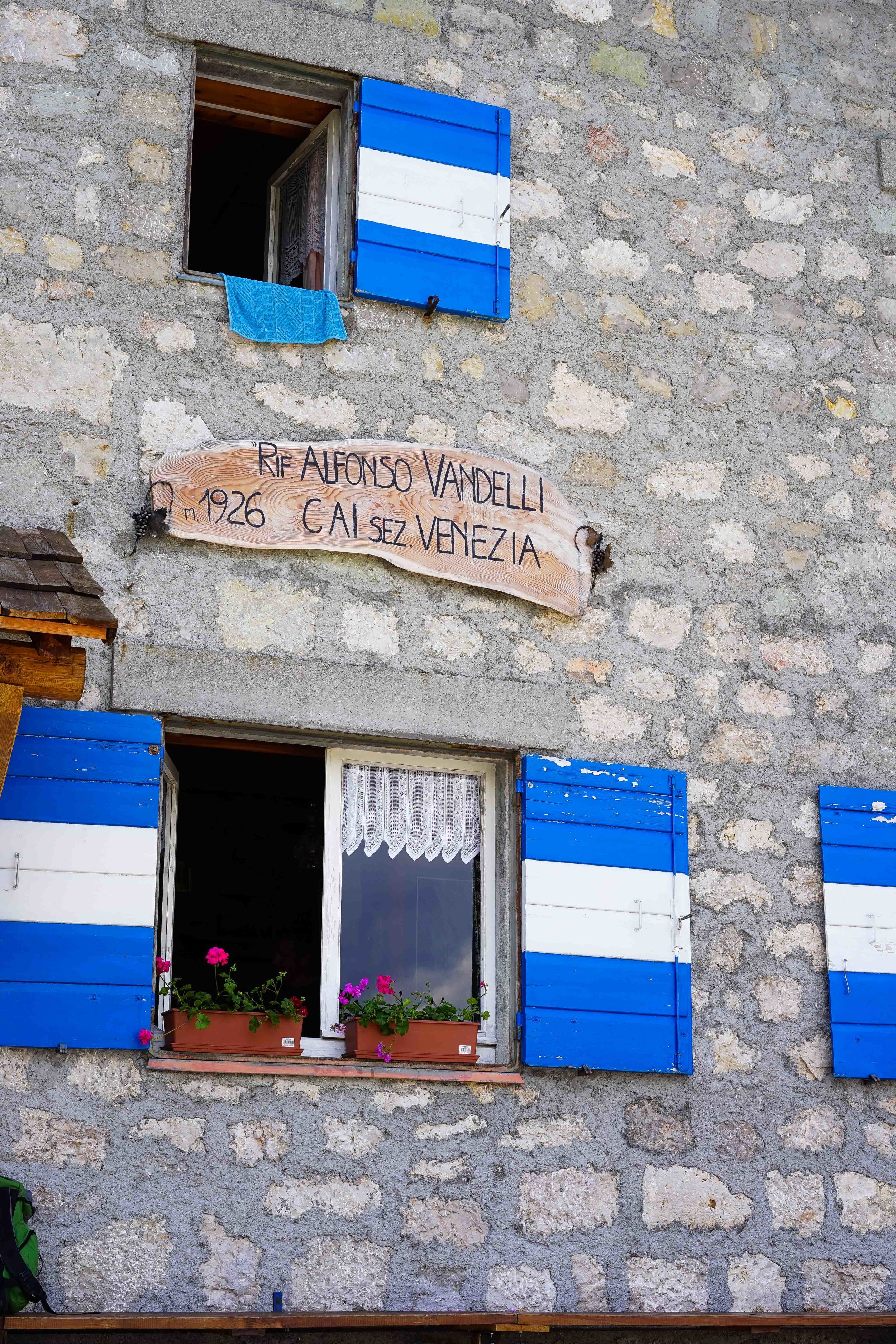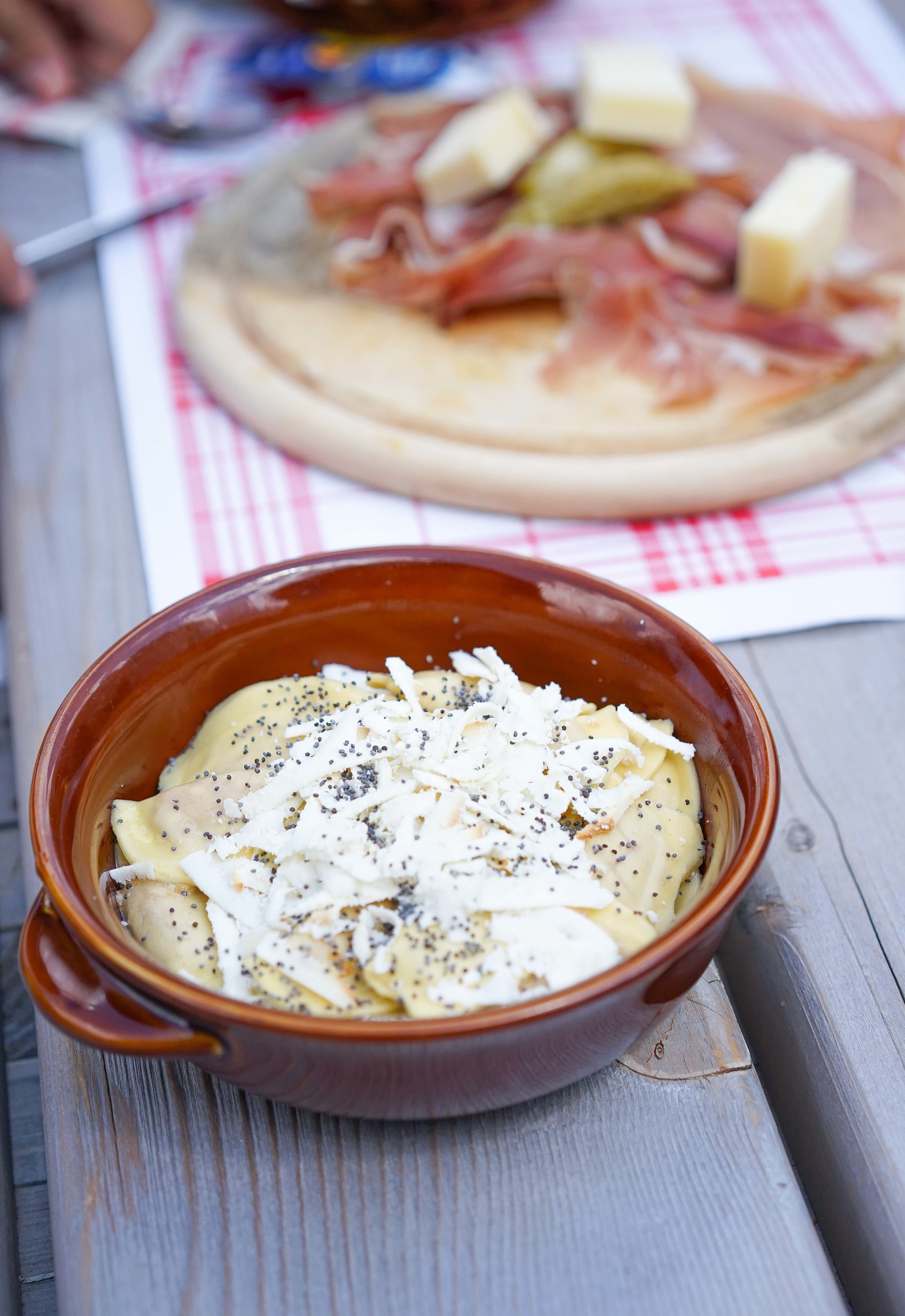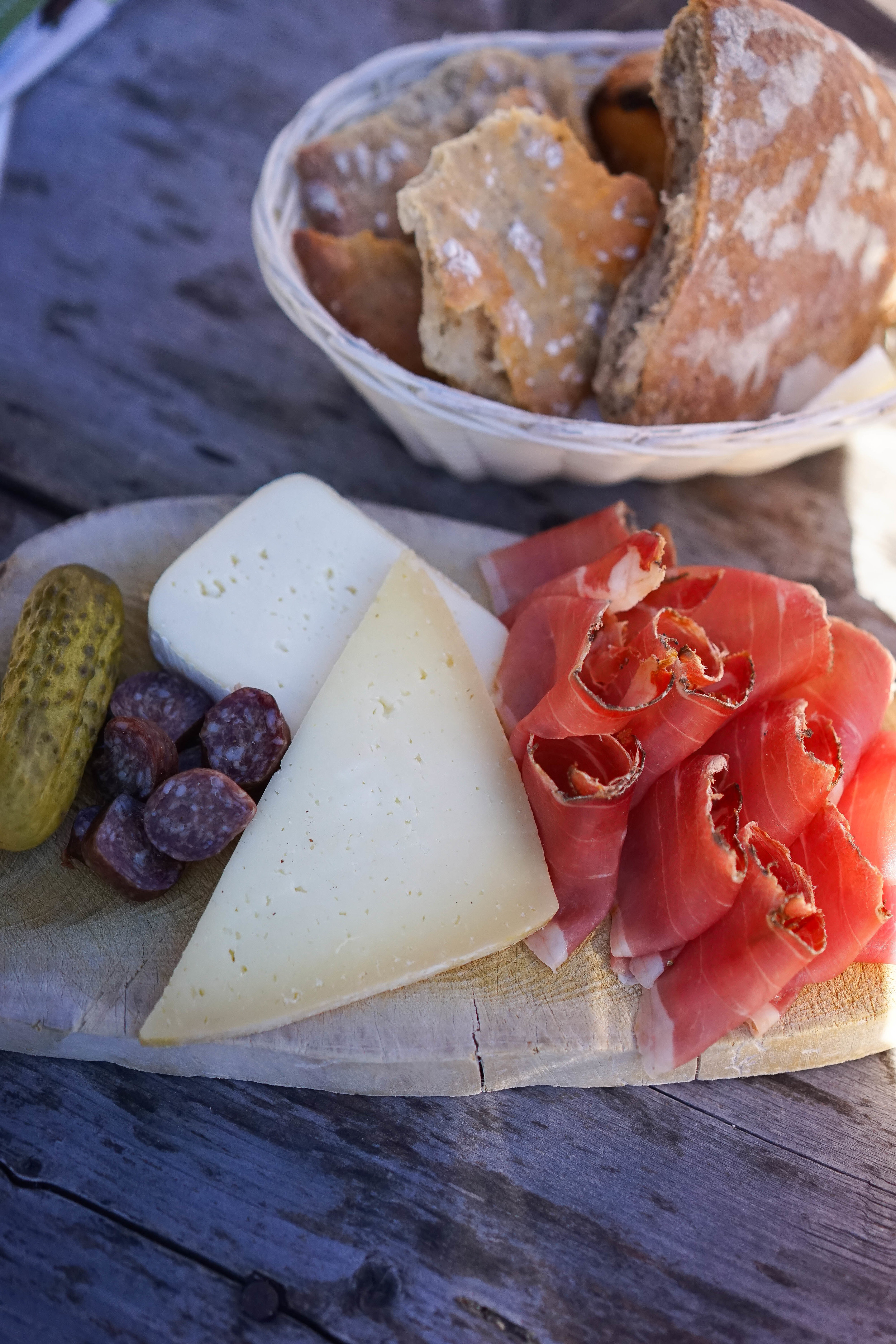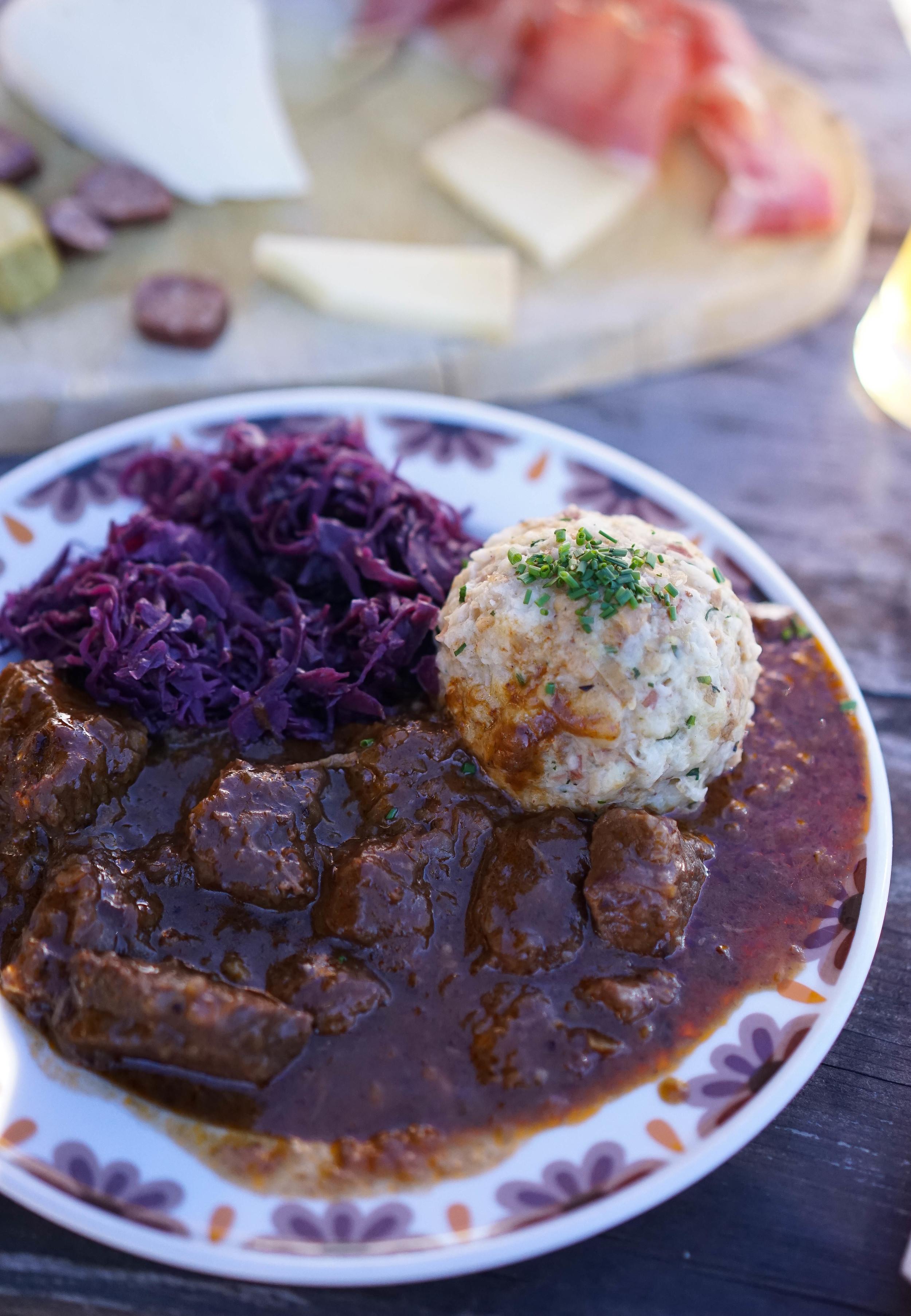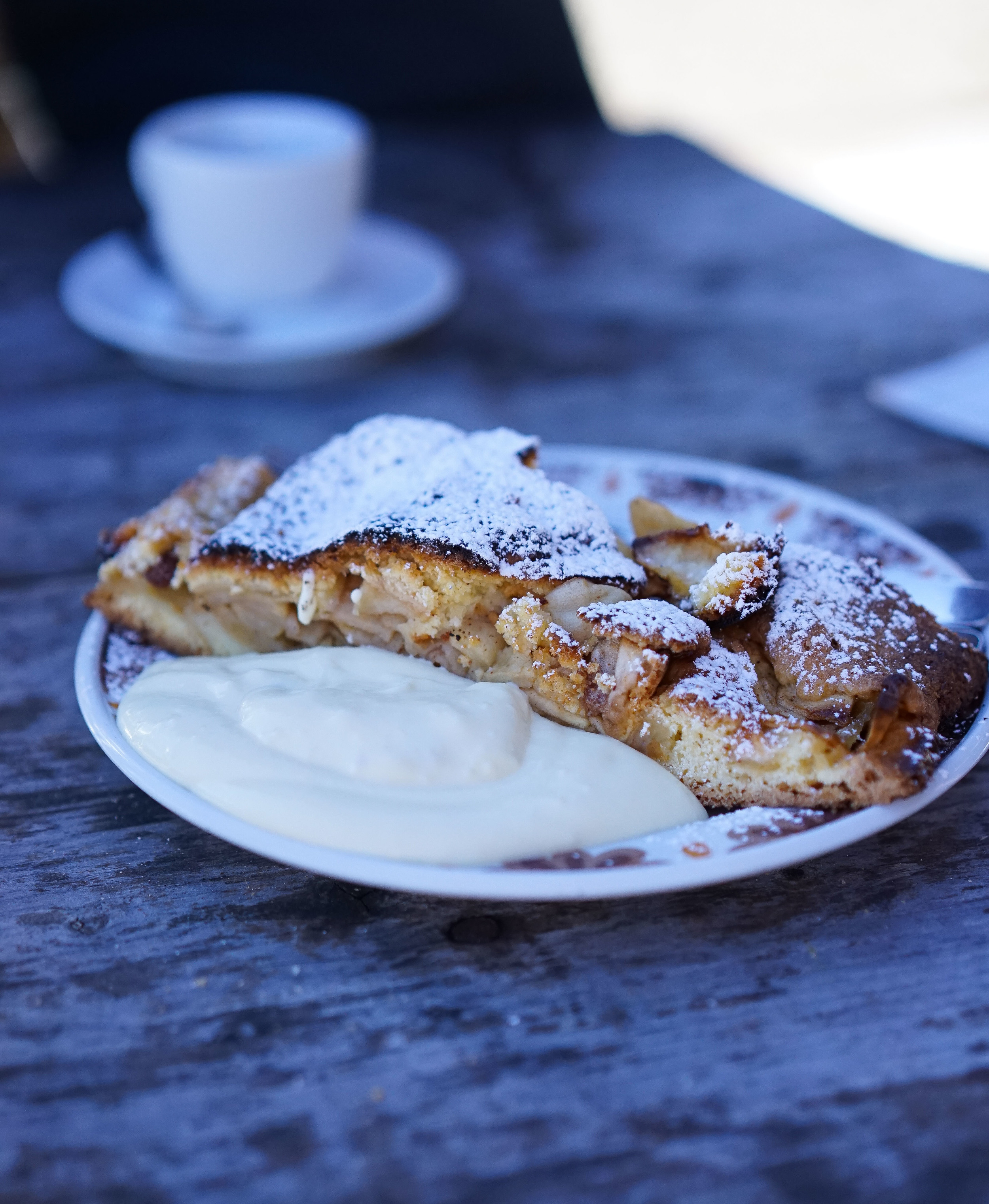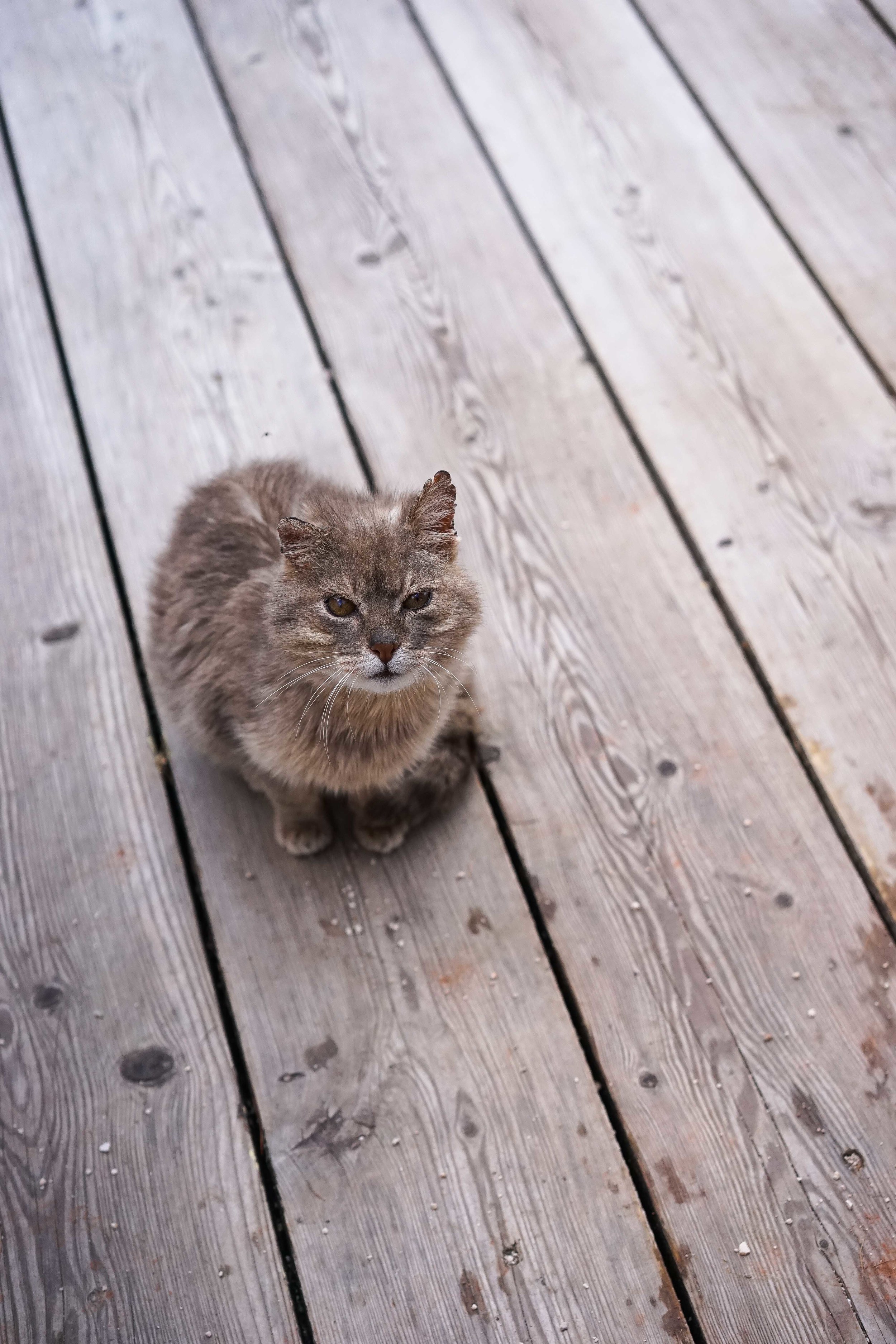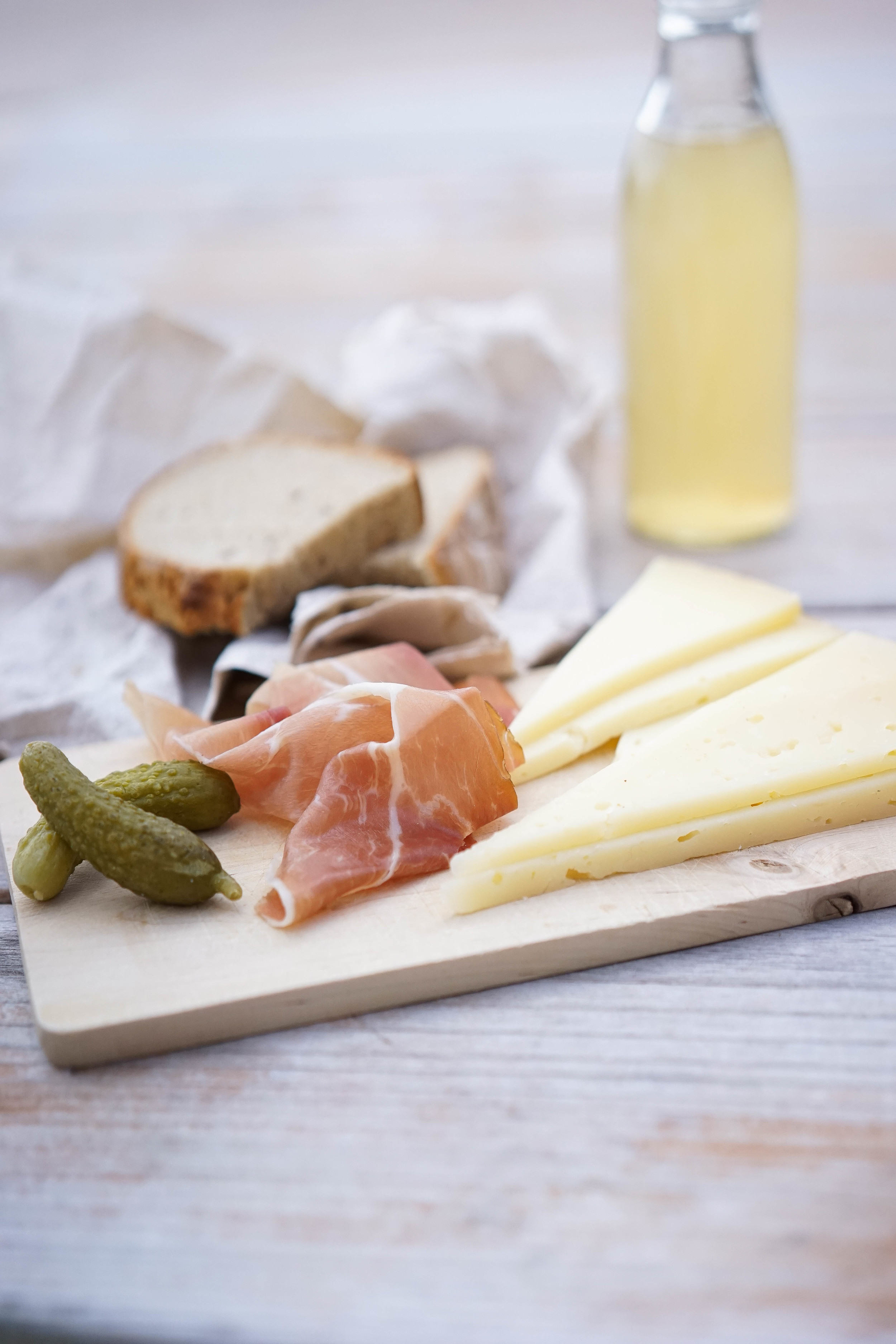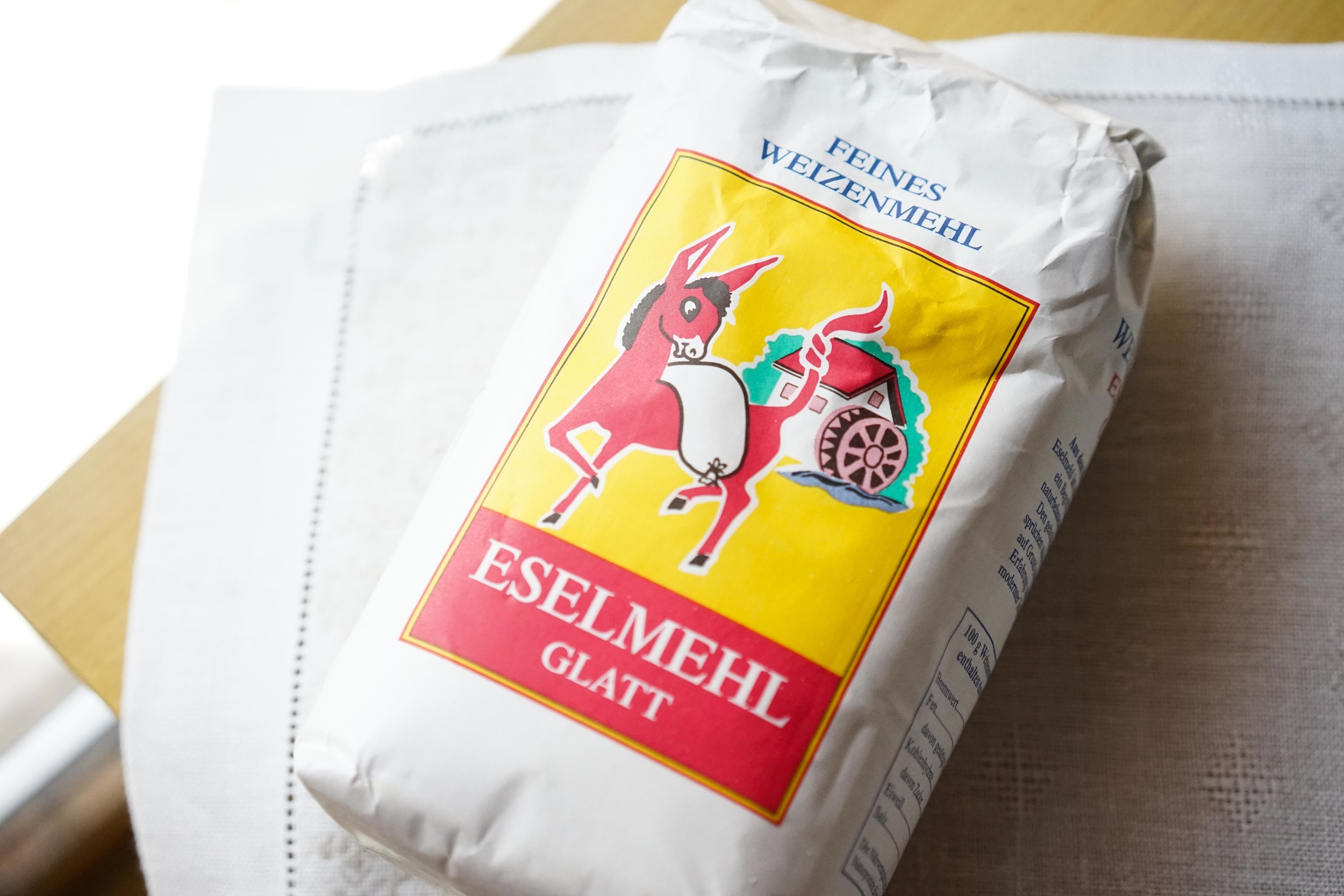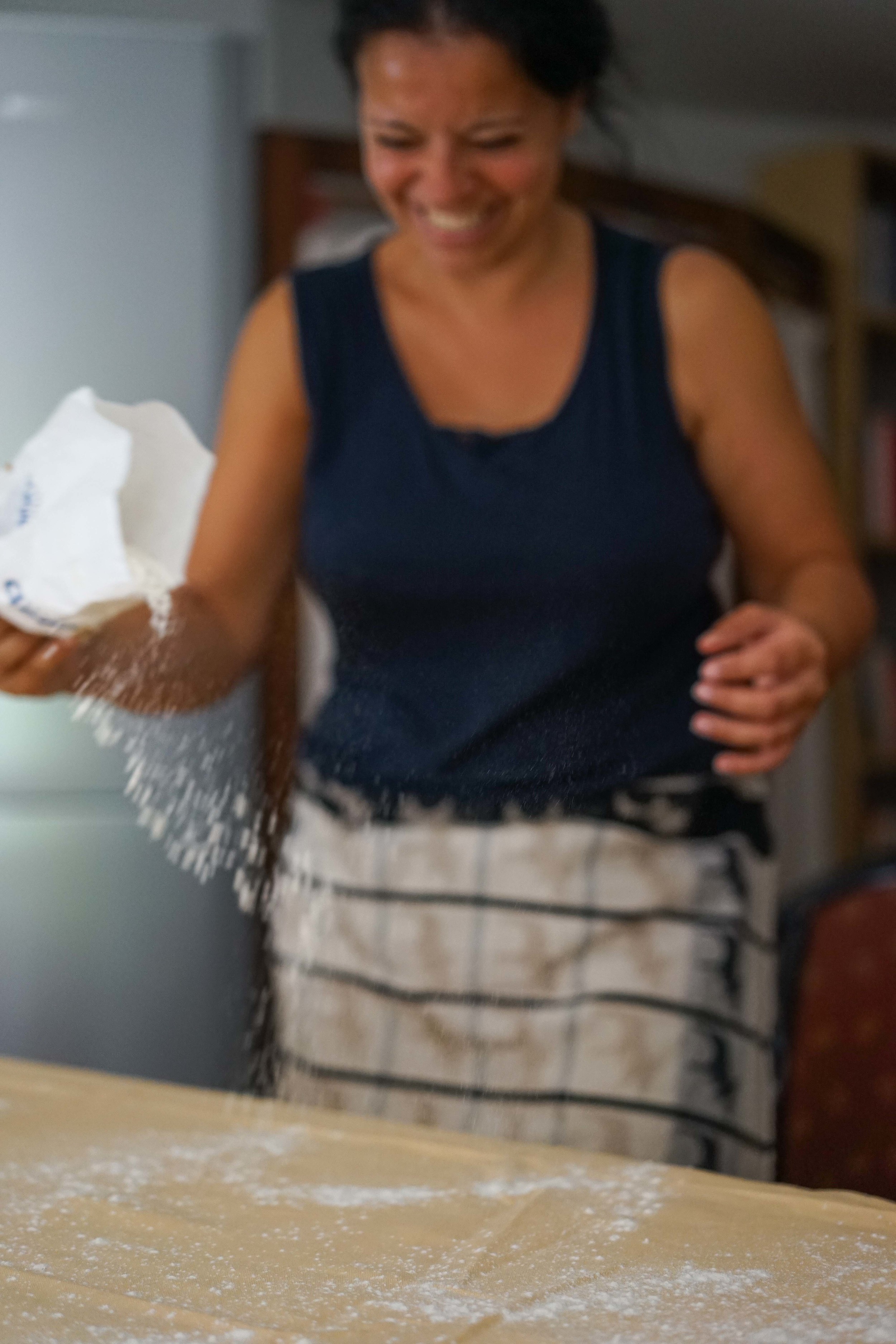Summer
It started with an email, just one line. It was the attached picture that did the talking. A lake, surrounded by rocky peaks iced with snow, its water an indescribable kind of blue, or maybe aquamarine, mixed with milk, and electrified. The question needn’t actually have been written, it hung in the air, blew coolly off the screen, 'Shall we try to find it?'
The venerable stones of Venice baked that June day. No relief to be had through the opening of windows – vapour rose off the shallow lagoon, thickening the air, hanging in sheets, putting paid to that illusion. Upstairs, in my rented flat, looking out from the kitchen, you could just about make them out on a clear day, jagged and still snow-capped to the north, a line of high mountains – Le Dolomiti, the Dolomites. A world away, (but only a short bus ride!).
Plans were gently formed, a few inquiries made. “This lake, it really does exist? And you’ve been?” “Well, no,” they said, “we haven’t yet been ourselves, but we know people who have… not too long a hike, I wouldn’t think, abbastanza ben battuto.” The internet lent its weight to this sentiment, ‘well trodden,’ it echoed again and again, or well ‘beaten’ as an Italian would put it.
This was fortunate as we were none too well prepared for mountaineering. Between us just some brightly coloured trainers and stretchy trousers. Our Tracy Anderson kit we called it, that small collection of well-intentioned items that manage to come on every trip yet never see the outside of the suitcase, (in much the same way that a workout DVD by the fitness guru of that name is equally unlikely to ever see the outside of its packaging). An opportunity now however! And so we bought a small backpack (our one concession to ‘equipment’), packed our Andersons inside, and caught the very next bus to the mountains.
The day was bright, the meadows green, and the path as ‘ben battuto’ as we and our flimsy workout gear could have hoped. Follow trail number 215 in a straight line seemed to be the instruction, very few forks in the road, easy enough. And so we did, a gradual climb, through forests of pine, midway between high peaks above and grassy valley floor a distance below. For some time we walked along like this, skipped along one might say, for our mood was as light as our barely-shod feet, on our way up to the fairytale lake, hoping for a fairytale lunch at the little rifugio that, we could see from the map, was situated very nearly on its shores. For really quite a long time we walked…
The question did begin to niggle – "the lake in the picture, you remember, it was completely surrounded by a ring of stone peaks, and we are here, in the forest, walking straight along, high, but not so high, and the peaks, they’re up there…" The map however, confirmed that we were still on the right path – still on the solid pink line of the 215, and not too much further to go – just some more solid pink, and a few bits of pink with cross-hatching. We looked to the key for some explanation this cross-hatch – ‘via ferrata’ it read. ‘Iron way,’ something of that sort, we translated, roughly, which meant…? A sharp right-hand turn was to provide the answer.
A via ferrata is a thick metal cord, strung along the edge of a precipice, held in place with a series of iron pins, driven deep into the rock. The idea is to attach a carabiner to the cord, or more than one to be safe, and for the carabiners to be attached to a climbing harness, worn over both legs and fastened tight at the waist. We did not have carabiners, nor evidently, a harness. We did have hands, and determination, and age-old good advice to offer one another – “Don’t look down!” Clinging on with fists clenched to the cord, crab walking along the edge of the first cliff, and then the next, and the next, we yelled this back and forth, volleyed it at high-pitch, perhaps not altogether encouragingly.
Smoke from the rifugio chimney, like a land bird sighted by a lost mariner, was the first sign of our salvation. It seemed very far away at first, but with no more ‘iron way’ to negotiate, we came quickly upon it, and a few steps beyond, the fabled lake! More impossibly blue even than we'd imagined. A clear, still pool of glacial snow melt, never more than eight degrees celsius, even at the height of summer. Although this we only learnt later, after going home and googling it. At the time, temptation was too great, and it’s only thanks to the warmth of the shore-side rocks, where we lay lizard-like to recover, that hypothermia was staved off!
Saved by rocks, and a warm rifugio lunch. Cured meats and cheese on a wooden tagliere with fresh home-baked bread, a terracotta bowl of casunziei all’Ampezzana (beetroot ravioli) tossed in brown butter and poppy seeds, a grating of ricotta salata on top, then for dessert, apple strudel with a pillow of softly whipped cream. Weiss beers and little coffees, and renewed energy found to face the ferrata once again…
We’d very nearly made it back when the thunderstorm started, only another half hour or so to the end of the path, (and the more death-defying stretches thankfully long past). No raincoats, of course, in the backpack of ill repute, but the fat rain drops were warm, the summer storm fleeting, the rainbow worth it, and things going skippingly once again. We’d found it, seen it, swam it, lived to tell the tale! ‘Ben battuto,’ not entirely, but then what would have been the fun in that?
Autumn
An overnight train going north – from Rome this time – sounded quite romantic to me, like something from a bygone era. Racing along the platform, late as always, searching for the right carriage, bundled up against the night November air, baggage in tow and whistles blasting – it was quite romantic. The onboard accommodation however, sadly a little less so. Fold down bunks attached to the ceiling via dubious looking fabric straps also gave the impression of another age, but not an illustrious one. The look of a hastily assembled field hospital in a very un-glamorous war.
But underway, things improved. The faint rattle and squeak of the brakes, the sigh-like release of breath everytime the train came to a halt, the quiet hour spent stopped in a siding to ‘moderate the service,’ (really to allow everyone, including the driver, to get some decent sleep). The incredible speed of plane travel makes nothing of the miles, of the distance covered. You wake up in another world, a few movies later, and don’t quite know how you got there. To say that you feel every mile on a train is to make it sound like a curse, but I love the repetitive rattle, the ground not too far below. The way that when you wake up somewhere new it’s still somewhere connected, tangibly, by a solid line of iron rails and wooden sleepers no less, to the place from which you’ve come.
We woke up still in Italy, but that’s not to say it wasn’t a different world. Officially, the train finished its journey at Merano, in the Alto Adige. Unofficially, historically, experientially, we’d arrived at Meran, Südtirol. This was confirmed by our taxi driver, not in as many words, but more in that I didn’t manage to understand a single word he said. At which point we ran out of attempted conversation, and of road. He got out of the cab and pointed instead, up the mountain, towards a cable car.
At the top of the cableway was a hotel, architecturally designed (so the literature at reception informed) to resemble a tree fallen in the forest. One long ‘trunk’ of rooms, a sloping roof covered in grass. In some places, mature trees seemed to grow out of the structure itself. From certain angles, it did not very much resemble a building at all.
Which is fortunate, because to be a building in this landscape would very much be the exception. On every hillside, and in every conceivable shade of autumn rust, trees, a multi-ranked army of them, pointy tops spiralling skywards, a giant bristling romanesco of pines.
I have with me, this time, some vaguely more appropriate ‘hiking’ clothing. I have not, as yet, invested in actual hiking boots. Our destination, another lake, another rifugio, is not far, neither is the path particularly treacherous, nor does it rain. Colourful trainers, mud-streaked as they become, prove no impediment whatsoever.
The stone rifugio, situated on a smaller and less improbably coloured lake, has a similar offering to the last but with a seasonal twist. Canederli allo Speck, dumplings of bread and cured mountain ham, served in a pool of slow-cooked beef goulash, some red cabbage sauerkraut alongside to brighten the mood. While canederli themselves can be found served across the entire stretch of the Dolomites, to find them in a plate of goulash is a little less common. A relic of Austro-Hungarian rule, heavily flavoured with caraway (which is known in these parts by its German name ‘kümmel’), and tasting more like something you might expect to eat in a Budapest beer hall, Südtirolan goulash is a perfect example of that oft-said thing – “there is no such thing as ‘Italian’ food.” What there is instead, and all the better for it, are the rich and varied food cultures of twenty distinct historically, geographically, culturally diverse, and often surprisingly incongruous, regions.
Back at the lodge, the afternoon vibe is somewhere between eco-minimalism and 18th century sanatorium. This crossover is most acute in the so-called ‘wellness’ or sauna area. Here, signs advertise very clearly a strict set of rules concerning dress. Or more specifically, undress. The sauna itself, with one entire wall made of glass, looking straight out onto the forest, is a clearly designated ‘no swimwear’ area. Towels too are banned. Much conditioned by my recent years in the Middle East, (perhaps also by recent months in relatively prudish Italy!), I flout this rule, remain attired, and pray that no white-coated spa frau appears to tell me off! Something I’m sure could never happen were we really still in ‘Italy.’ Here, I don’t like my chances…
Winter
From the first day of the year, until the last day of spring, we rented a small place in Cortina. A friend of a friend found it for us, the first house you see as you drive into town. La Casa Gialla we called it, for its painted stucco exterior, which was closer to ‘albicocca’ but without the same ring. We should have called it ‘La Pigna,’ for while it was stucco on the outside, it was pure pine within. Pine ceilings, pine floors, pine windows, walls, and doors. A kitchen made of pine, a dining table too, and six pine chairs each with a little heart shape cut out of the back. The sofa – not pine − was red, and overloaded with embroidered cushions depicting deer and trees, little cottages, and high mountains. On the windowsills and sideboards, leftover Christmas decorations – wreaths of fake holly and poinsettia – gathering dust. These I could hide in a cupboard, the rest of it grew on me, in time.
Through January there was little snow, just a dusting, the faded green of the land still visible below. In February when the blizzards arrived, some friends did too, and when the white wafts became too thick to see through we sought refuge in the rifugi once again, taking our time over lunch.
When we were good, we ate warms bowls of barley soup, filled with cubes of potato and cured ham. When we were bad, we ate mounds of golden polenta and grilled sausage, slabs of cheese melted on top. Or a hash of bacon, onion, and crispy potatoes, crowned with fried eggs, washed down with homemade grappa, (a digestivo, taken for medicinal reasons of course!); the schuss and slide down always a little less graceful afterwards...
Each rifugio a different grappa, always made in-house, usually flavoured with mountain herbs. Ginepro (juniper) and ortica (nettle) I knew, others, such as the mysterious ‘ruga,’ I’m yet to find a translation for. One place had one bottle with a small snake suspended within. “What does it taste like?” I asked to shrugged shoulders. “No one has ever tried, but, eh – it looks good, right?!” My favourite? Always the kümmel, and the hospitality of a bottle left without asking on the table at the end of a meal by staff accustomed to lengthy snow flurries and even longer lunches.
Back at the house, too full of an evening to venture out, we made our own entertainment. Launching prosecco corks from the small balcony onto the snow beneath, a winter sport yet to catch on in a widespread way. Different brands of course, so we’d know whose was who’s, farthest cork wins, and one simple rule – no spillage allowed! Only, it was hard to see the corks in the dark, too cold and too snowy to be bothered going out to check… We did eventually, in the spring. Three clumped near-ish we found, and one more, ahead. A winner, but who? Recollection long gone, likely erased that very night by bottle contents... Next year, a permanent marker pen, and a re-match!
Spring
I return on my own in last week of spring, Heidi song on loop in my mind, a pair of hiking boots (finally!), shiny and new, hanging from my bag, begging to be used. Snowmelt and warm sunshine has turned to wildflowers – I tried to avoid treading on them, at first, but they are a sea, knee deep and yellow. ‘Heidi-ho’ I sang, and that ‘buttercup’ song, then an improvised ‘peonies on the soles of my shoes.’ But it wasn’t just flowers and trees for company, there was some wildlife too, when my singing didn’t scare it away...
First – doe-a-deer! More surprised to see me trundling down the path than I her, and also quicker to react. Before I could reach for my camera, the little fawn was gone, straight up the steep slope and into the trees. A lake full of trout came next. In the clear green water they were easy to see, their outlines casting well-defined shadows on the sandy lakebed. ‘No Fishing,’ read the signs, tacked to the trees. No fishing indeed, it would hardly be fair!
A bit more of a relationship forged with my next friend, encountered on the deck of a boarded-up rifugio at 2055 metres. I stopped for a picnic lunch and within minutes of the prosciutto appearing so did she: a little grey cat, on the mangy side, with torn ears, and the long feet of a hare. We shared lunch, the ham and cheese were delicious, we both readily agreed, though she might have been more polite about my homemade bread...
I am grateful that there are no witnesses to my final wildlife encounter of the day. From the corner of my eye I saw it – a large blur of dark brown descending from a tree at speed. My heart stopped, I may have yelped – ‘a bear?!’ (I knew this was impossible). A ‘tree wolf?’ my next entirely inexplicable thought. The blur stopped, and separated. Out either side of the tree trunk, daintily balanced on twin branches, two tiny squirrels, triangular tufted ears pricked in my direction (presumably awaiting further yelps). Eventually, they went back to chasing one another up and down the trunk, leaving me to ponder that old cartoon, was he called 'Taz,' that whirlwind Tasmanian devil?
Out of the forest and back over the meadows, limping now, not skipping, towards home. My new boots are beautiful, but well worn-in, they are not. The thunderclouds had threatened dryly, but now warm raindrops splash the earth, chasing me those last steps. A reminder that my Dolomiti year has come full-circle, a welcome push from the outdoors inside, and to the kitchen.
Spring...
Casunziei all’Ampezzana / Beetroot Ravioli with Butter & Poppy Seeds
This recipe requires a bit of equipment in the form of a pasta machine, and a potato ricer. If you don’t have a ricer, that’s ok, because at a push, a fork can do its job. The pasta machine, however, is less easily replaced. The first time I made this recipe, back in the Venetian flat, I didn’t have one, and although my rolling-pin efforts weren’t totally disastrous, neither were they, let’s say, ‘optimal’! Subsequent, machine-assisted, attempts have produced a much thinner pasta, and resulted in lighter, more delicious ravioli.
With regards to fillings and toppings. Some recipes for casunziei call for ricotta in place of potato, it’s up to you which you’d prefer to use. I come down on the side of potato as what you really want to taste in casunziei is beetroot (the additional filling ingredient is there mostly to mop up the runny juices) and potato, to me, is more neutral in this role.
Ingredients
(Serves 4)
For the dough
- 400g “00” flour
- 4 medium eggs
- A pinch of salt
- A little semolina for dusting
For the filling
- 600g fresh beetroot – approx. 6 medium beetroot
- A little olive oil
- 1 medium floury potato – approx. 250g
- 50g parmesan
- ½ a nutmeg – finely grated
- Salt & freshly ground black pepper
To serve
- 1 tablespoon of poppy seeds (semi di papavero)
- 75g butter
- 25g grated parmesan
Preheat the oven to 200°C.
Prepare the beetroot for roasting by rubbing lightly with some olive oil and salt. Wrap in a large sheet of foil and bake for around an hour and a half in a hot oven. A test with the tip of a sharp knife will tell you when the beetroot is cooked through.
Meanwhile, boil the potato whole, without peeling, in a pot of lightly salted water until the same ‘knife test’ says that it is cooked through too.
Start the pasta dough by placing the flour in a mound on a clean surface. Make a large well in the middle and, one by one, add the eggs, along with a good pinch of salt. Whisk these together lightly with a fork, beginning to incorporate the flour ‘wall’ bit by bit as you continue to whisk.
When you can no longer whisk with a fork, begin to mix and knead the dough with your hands, bringing it together to form a large ball. Continue to knead until the dough feels smooth and elastic (around 10 minutes), then wrap tightly in cling film and put aside to rest at room temperature for at least 30 minutes.
Peel the skins off the cooled beetroot then, using a box grater, grate finely into a large bowl. Peel the skin off the potato, then push this through a ricer, and mix together with the beetroot. Season the mixture with a little salt, some freshly ground black pepper, and the nutmeg.
To roll the pasta, cut the dough into six equal portions. Work with only one portion at a time, leaving the others aside, still wrapped in cling film.
Dust your surface and pasta machine with a little flour, then, with the machine on its widest setting, crank the first portion of dough through. Fold the rolled dough in half after this first go, and then continue to roll it through again and again, continuing this pattern of rolling, folding in half, and turning over another 5 or so times until the dough is feeling elastic and looking smooth.
You can now continue through all the settings of the pasta machine, rolling the dough through at least once on each setting, folding, and feeding it back through, until you reach the final setting, and the dough is nearly paper thin.
Using a straight-edged scone cutter of between 10-12cm in diameter, cut circles in the pasta then place a teaspoon of the filling in the centre of each. Next, dip a finger into a glass of cool water, and trace the edge of each circle with a little water so as to dampen it ready to form a good seal. Now fold carefully in half in order to form your first round of crescent-shaped ravioli, pressing the edges of each together firmly, and squeezing out any pockets of air as you go. Remove the finished ravioli to a tray that has been lightly dusted with a bit of semolina, (this will prevent them from sticking), taking care to place them apart from one another, and in a single layer.
Continue on to roll the remaining portions of the dough, (offcuts from previous rounds can be incorporated into the next so long as they haven’t dried out too much), until all the dough and filling is used. Then, space permitting, place ravioli trays in the fridge for around half an hour to rest.
Bring a large pot of lightly salted water to the boil ready to cook the casunziei. Add these with the heat turned down to give a gentle boil as opposed to anything more energetic. In just 2-3 minutes cooking time they’ll be done, so be ready to go at the same time with the burnt butter sauce.
Make this by melting the butter over medium heat, then adding the poppy seeds, and allowing the butter to turn from golden to nut brown.
Remove the casunziei carefully with a slotted spoon and arrange on individual serving plates before pouring over the butter. Some parmesan, grated finely, almost to a powder, goes very nicely on top.
Canederli all’Ortica con Burro & Salvia / Stinging Nettle Dumplings in Brown Butter & Sage
I’m partial to stinging nettles for a few reasons – primary amongst these, they’re free! They are also a weed, so by picking them, you’re doing someone a favour. Then there is the frisson of danger involved in avoiding the spines, a weird sense of achievement when, having boiled the nettles, these are miraculously disabled. They are also, apparently, very healthy for you, (though this reason comes further down my list).
Pick the young shooting tips in spring, wearing a pair of decent rubber gloves, preferably the sort that go almost to the elbow, and don’t forget to rinse the kitchen scissors afterwards! Once the nettles make contact with boiling water, the fine stingers melt instantly, and the cooked leaves can be used in much the same way as spinach.
Ingredients
(Serves 4 – 3 dumplings per person)
- 300g stale white bread
- 200ml warm milk
- 800g stinging nettle tops
- 30g butter
- 1 small onion – finely chopped
- 1 clove of garlic – finely crushed
- 2 eggs
- Salt and freshly ground black pepper
- ½ a nutmeg – finely grated
- 1 tablespoon plain flour
- 2 tablespoons of breadcrumbs
- 80g butter, for the brown butter (burro fuso)
- Small bunch of fresh sage – leaves picked
- Grated parmesan (around 50g) for sprinkling
Cut the bread into cubes and place at the bottom of a large bowl. Pour over about ¾ of the milk, and place aside to absorb at room temperature while you prepare the nettles.
Plunge the nettles into a large pot of boiling, lightly salted water. Take care as you do so, using gloves if necessary.
Boil the nettles for a few minutes, then drain. When they have cooled a little, remove to a board and chop them finely.
Next, gently fry the onion in a little butter until it softens. Add the crushed garlic and turn the heat down even further, stirring to ensure that it does not stick or burn. Once the garlic is cooked, add the chopped nettles to the pan as well, mingling everything together, and cooking for a further 5 minutes or so.
Add the nettle mixture to the bowl containing the soaked bread. Separately, whisk the eggs together with some salt, pepper, and the grated nutmeg, then pour this over the nettles and bread as well.
Next, stir the breadcrumbs and flour into the mixture, and test the consistency – with wet hands, can you roll the mix into a coherent dumpling? If not, add a little more milk, or more flour and breadcrumbs (depending on whether the mix is too dry or too wet) until you achieve a roll-able consistency. You should get 12 slightly larger than golf ball sized dumplings from this recipe.
To cook the canederli, bring a large pot of salted water to the boil. Turn the heat down a touch to keep the water at a steady, but not violent boil, then carefully lower the dumplings in one by one. Cook for 15 minutes, turning gently with a spoon occasionally, before removing with a slotted spoon to drain.
Meanwhile, prepare the burro fuso by melting the butter in a pan over a medium heat until it turns a light nutty brown. Add the sage leaves when the butter is melted and hot, allowing them to flavour the butter as it darkens.
Spoon the burro fuso and crisp sage over the warm canederli on individual plates to serve, along with a scattering of grated parmesan.
Summer...
Lo Strudel Ampezzano / Ampezzano-style Midsummer Strudel
To make a strudel, it really helps to have a strudel cloth. This is a piece of fabric, never washed, heavily floured, and employed only in the rolling-out, and rolling-up of strudel pastry. I don’t have an ancestral strudel cloth, but fortunately, back in her Venetian kitchen, my comrade in death-defying via ferrata trapeze did have. She inherited it from her granmother, along with an enviable set of strudel-skills, and an ancestry that can be traced back, in part at least, to the Südtirol.
Two people are required to make a strudel – the pastry is first rolled thin on the cloth, but then needs to be picked up and pulled by hand from both sides to enlarge it and make it even thinner. This is actually easier than it sounds (though it may have helped that I had a master show me how to do it!).
We conducted the strudel experiments that resulted in the recipes below on a stifling hot day back in Venice, more of a granita day than a strudel one, but we were no less dedicated for it. After experimenting with a host of different fillings, and narrowing down the field, we couldn’t decide between these last two, and so I’ve included both…
Ingredients
(Makes one large strudel – 8-10 slices)
Pastry
- 350g Austrian glatt flour, or cake flour, or an all-purpose flour from which you have removed two tablespoons worth and replaced these with cornflour
- 185ml tepid water
- 1 teaspoon sunflower oil + extra for basting
- Icing sugar for dusting (optional)
Choice of:
Pear, Cherry, & Pine Nut filling
- 300g ripe pears – peeled and diced
- 140g cherries – pitted
- 25g pine nuts (pinnoli) toasted
- 3 tablespoons breadcrumbs
- 30g white sugar
- ½ teaspoon ground cloves
- ¾ teaspoon ground cinnamon
Or, Cherry and Papavero (Poppy Seed) filling
- 350g ripe cherries – pitted
- 20g breadcrumbs
- 70g crushed poppy seeds
- 3 tablespoons sour cream
- 50g white sugar
Start by preheating the oven to 50°C.
Using a sturdy electric mixer, beat the flour together with the warm water and sunflower oil for around five minutes until they form a smooth and coherent dough, and the mixer is showing signs of struggle!
Remove the dough to a lightly oiled oven-proof tray. Brush the top lightly with a little more oil, then cover with a damp tea towel and place in the oven. At this point turn the oven off and allow the dough to simply rest inside for around 40 minutes.
Meanwhile, prepare your chosen filling:
For the pear, cherry and pine nuts: peel and dice the pears, pit the cherries, and toast the breadcrumbs lightly in a dry pan until golden. Lightly toast the pine nuts in the same pan watching them carefully as they can quickly burn.
For the cherry and poppy seed filling: pit the cherries, and measure out the other ingredients.
Now for the fun bit! Spread your ancestral strudel cloth (or erstwhile substitute) over a table, and dust liberally, from a height with flour. Take the rested dough from the oven, place it into the centre of the cloth and, using a floured rolling pin, roll it out as thinly as you can. Next, with the help of a trusty strudel-assistant, carefully pick up the dough and gently stretch from the centre towards the edges in unison – you should find that it stretches quite easily at first. When the pastry is getting very thin, (they say you should almost be able to see through it though this is perhaps a little aspirational), place it back down on the cloth and pull gently at the edges to stretch it just a little bit further. Never mind if you create a few little tears, just patch these up as best you can.
At this point, turn the oven back on and pre-heat to 180°C.
Next, sprinkle the sugar over the pastry (30g for the pear filling, a little more, 50g for the cherry) leaving a border at the edges. Then it’s time for your chosen topping. Spread the filling, like the sugar, over the centre of the pastry, leaving a border at the edges. For the cherry version, dab the sour cream over the cherries using a teaspoon, aiming for an even distribution.
To roll, use the cloth beneath to pick up one edge of the strudel, folding this over and continuing to roll up the pastry to form a sausage shape. Next, bring the ends of the rolled strudel towards one another to form a horse-shoe or crescent (I don’t know the ‘whys’ behind this final step, but am reliably informed that it is traditional!). Lastly, brush with a little extra sunflower oil before placing in the pre-heated oven to bake for 45 minutes.
Once the strudel is looking crisp and golden remove from the oven, and allow to cool slightly before slicing with a serrated knife. Serve with whipped cream, or a scoop of vanilla ice-cream.
Autumn...
Canederli allo Speck, Three Ways
Canederli allo speck are versatile little things and can be served in a number of different ways: with a bit of burro fuso and sauerkraut, in brodo (with clear broth and grated parmesan cheese), or on the side of meaty stew, positioned to soak up the juices. Recipe suggestions along each of these lines can be found below, along with the basic recipe for eight dumplings.
The ‘kind-of-kraut’ is a bit of an invention – sauerkraut is typically fermented, but I don’t always have the patience for that. The overnight version below is a cheat, more pickled than ‘fermented’ per se, but perfectly delicious all the same!
Ingredients
(All recipes below to serve 4 people, 2 canederli per person)
Canederli allo Speck
- 300g of day-old white bread
- 100g of speck (a mountain ham, substitute pancetta if unavailable) – cut into a small dice
- 1 small onion – finely chopped
- 20g butter
- 2 eggs
- Up to 400ml milk
- 2 tablespoons fresh chives – finely chopped
- 2 tablespoons plain flour
- Salt to taste
Cabbage Kind-of Kraut
The cabbage needs to marinate overnight (in place of the usual week-long fermentation), so start the day before you intend to use it.
- ½ a red cabbage
- 1 heaped tablespoon sea salt
- 1 tablespoon red wine vinegar
- 1 scant tablespoon of sugar
- Juice of half a lemon
- 50g butter
- Freshly ground pepper
- 80g salted butter – for the burro fuso
- Grated parmesan (around 50g) for sprinkling
Trentino Goulash
Like a lot of things, goulash tends to taste better the next day. Consider starting it at the same time as the cabbage if you plan on serving them together (highly recommend!), then it’s just the canederli to prepare on the day, dramatically reducing the number of things to juggle.
- 2 brown onions – finely sliced into rings
- 50g butter
- 2 tablespoons sunflower oil
- 800g stewing beef – cut into large cubes
- 2 tablespoons paprika
- 1 tablespoon of tomato paste, (not traditional, but it does a lot for the colour)
- A glass of red wine (around 250ml)
- 2 tablespoons red wine vinegar
- A few sprigs of fresh rosemary
- 2 teaspoons of caraway seeds
- 2 cloves of garlic
- Zest of one lemon
- Juice of one lemon
- A further tablespoon or so of butter
- Salt & freshly ground black pepper
In Brodo
- 1 small onion – finely chopped
- 1 carrot – finely chopped
- 1 stick of celery – finely chopped
- Olive oil
- 1.25 litres of fresh chicken stock
- Salt & freshly ground pepper
- Grated parmesan (around 50g) for sprinkling
To make the Canederli:
Cut the bread into cubes and place at the bottom of a large bowl. To this, add the diced speck.
In a small pan, fry the onion in the butter until it is soft and translucent, but not coloured. Add this to the bowl containing the bread and speck.
Next, whisk the eggs with around half the milk. Add the chives, along with some salt, and continue to whisk briefly before pouring the mixture into the bowl containing the bread.
Allow the bread to absorb the liquid by leaving it to rest at room temperature for around 30 minutes. After this time, add the flour, and mix through a little more of the milk if the bread is looking on the dry side.
To form the canederli, rinse your hands in cool water, and try forming a little of the mixture into a ball. It might be a touch sticky, but keeping your hands wet should help. If the dumplings are really too sticky, add a little extra flour to the mix.
Place the rolled canederli onto a plate and place in the fridge to rest, once again for around 30 minutes.
Meanwhile, bring a large pot of salted water to the boil.
Lower the dumplings carefully into the pot, and turn down the heat to sustain a low-medium boil. Cook for around 15 minutes, gently turning them in the water once or twice as you go.
To serve, remove from the pot using a slotted spoon, and prepare in one of the following ways…
Method: Kraut
Remove the outer leaves of the halved cabbage then slice in half again. Remove the white core from the centre of each quarter by making a v-shaped incision with a large knife. Next, turning the quarters on their side, slice the cabbage very finely as though for a coleslaw.
Transfer the sliced cabbage to a bowl, add the sea salt, and, using your hands, begin to massage the salt into the sliced cabbage. This will release water from the cabbage, making a brightly coloured brine that will gather at the bottom of the bowl. (It will also stain your hands an alarming, but temporary, colour. Consider gloves if you don’t fancy being red-handed for the next few hours.)
Continue ‘massaging’ by picking up big handfuls of cabbage and squeezing to blend through the salt and release more water until the pile of cabbage is a lot softer than when you started, and reduced in volume by about a third.
Now add the vinegar, sugar, and lemon juice, and stir through, with a spoon, or with hands! Leave to marinate at room temperature overnight. It will be ready the next day.
Prepare the burro fuso by melting the butter in a pan over a medium heat until it turns a light nutty brown.
To serve, place two warm canederli on each plate, spoon over the brown butter, and add a little kind-of-kraut to the side.
Method: Goulash
Heat the oil and 25g of butter in a heavy-based pan with a lid. Add the onion and cook gently until softened and golden in colour.
Using a wooden spoon, push the softened onions to the side of the pan, piling them up on top of one another then re-position the pan slightly, so as to distance the onions from the heat a little, as you turn this up to cook the beef.
With the heat now up high, add the beef. The residual oil that coats the pan should be sufficient to brown the beef, but if your pan is looking very dry, add just a touch more first and let this become hot. Allow the beef cubes to sear and darken on each side before turning over. Unless your pan is very large, you may need to do this in batches – add a little extra oil and butter as you go along as required.
When the beef is sealed on all sides, reincorporate the onions, add the paprika, along with the tomato paste, and season generously with salt and pepper.
Next, with the heat still on high, add the wine and the vinegar, scraping the sides and bottom of the pan with a wooden spoon to dissolve any caramelized bits as you do so. Allow the liquid to reduce down for a couple of minutes, before adding 150ml of water, and bringing to a boil. Once boiling, cover the pot with a lid, and reduce the heat to the absolute minimum, (it helps to use the smallest hotplate/stove ring, so move the pot across to this if currently positioned over a larger one).
The beef will take up to three hours to become absolutely soft – ideally, it should pull apart with a bit of pressure from the back of a fork. In the meantime, as it cooks, check occasionally to make sure that there is still liquid in the pot, add a little water if things are looking dry (but only a little, as the idea is to cook the meat largely in its own juices), and stir occasionally to make sure nothing catches and sticks.
As the beef cooks, prepare the remaining ingredients – the rosemary, caraway seeds, garlic, and lemon zest, by chopping everything together very finely. It may seem odd to add these at the end as opposed to the beginning, but if cooked over the length of time that the beef requires, the flavours of the caraway, zest, and rosemary can tend to dull and be overwhelmed by competing flavours. Introduced late in the piece, their taste is kept sharp – especially important for a goulash, where the acidity of the lemon and vinegar provides a contrast to the smoky paprika. This is also a good trick for any slow-cook curries. Cardamom, for instance, when snuck in towards the end has a much clearer flavour than when added at the beginning.
When the beef is nearly ready and has already become tender and begun to break apart a little, add the chopped rosemary, caraway seeds, garlic, and lemon zest, then stir to combine. Continue to cook for another 15-20 minutes. Taste and adjust the seasoning if necessary before removing from the heat.
Lastly, add the lemon juice, along with the extra butter, and stir through.
Serve in a shallow bowl, with one or two canederli on the side, and a little bit of the bright purple kraut.
Method: Brodo
Lightly fry the onion, carrot, and celery together with a little oil olive over low-medium heat in the bottom of a large pot. When these have softened, and become translucent, but not coloured, around 5-7 minutes, add the chicken stock. Bring to a boil, then turn down the heat, cover, and allow to cook for around 15 minutes.
To serve, place two canederli in a shallow bowl, and ladle the broth over the top. Sprinkle with a little grated parmesan.
Winter...
Minestra di Orzo / Barley Soup
I am not sure I could bring myself to eat a buttery pool of polenta trapped under a slab of melted cheese anywhere other than a freezing mountain top… So here instead is the ‘healthy’ choice amongst the mountain winter options (I am sorry if that disappoints) − a tasty, kind-of wholesome, barley soup!
Ingredients
(Serves 4)
- 100g speck (a mountain ham, substitute pancetta if unavailable) – cut into small dice
- 1 small onion – finely chopped
- 100g orzo/pearl barely
- 1¾ litres of water
- 1 medium potato – cut into medium cubes
- 1 carrot – finely chopped
- 1 stick of celery
- Salt
- Grated parmesan to serve
Fry the diced speck in a large pot over medium heat until it begins to release some oil, and darken slightly. Now add the diced onion, and turn the heat down to cook this slowly, together with the speck, until it turns translucent.
Next, add the pearl barley, stirring to coat this with the speck and diced onion. Then add the water, along with the cubed potato. Bring to the boil, then cover and turn the heat down to a simmer. Cook slowly for up to an hour and a half.
When the soup is around 30 minutes from being ready, added the carrot and celery. Adding them here towards the end helps keep their flavours fresh and present. You can also taste the soup at this point and season with salt as necessary.
To serve, ladle into warmed bowls, and sprinkle some grated parmesan on top.
Puccia con Kümmel / Dolomiti Rye Bread with Caraway Seeds
On the table of every Dolomiti rifugio from summer through winter, you’ll find puccia, a type of rye bread flavoured with caraway seeds, served either as a fresh loaf, or a dried ‘cracker.’
This recipe is for the fresh version and makes one medium-sized loaf. Add more caraway if you like it; if you don’t, probably best not to attempt this recipe!
Ingredients
- 300g white bread flour
- 500g rye flour
- 30g natural yeast
- 1 teaspoon of sugar
- ½ - ¾ litre of milk – room temperature
- 1 scant teaspoon of salt
- 2 tablespoons of caraway seeds
Mix the two types of flour in a large bowl, leaving a large well in the centre. Into this, crumble the yeast, and add a small amount of the slightly warmed milk – less than half a cup. Also add the sugar, then cover with cling film and leave in a warm place in order to let the yeast activate for around 15-20 minutes.
Next, add the rest of the milk, as well as the salt and caraway seeds, and mix into a dough. Knead the dough until it is completely smooth, around 10 minutes, adding a dusting of flour as you do so when it begins to feel sticky. Leave proof for a second time, covered again either with cling film or a tea towel, until the dough doubles in volume – this should take about an hour.
Turn the risen dough out onto a floured surface and form it, using a little extra flour as is required, into a circular loaf.
Place onto a baking sheet dusted with flour, and leave to proof once again for around an hour.
Meanwhile, preheat the oven to 200°C.
Once the bread has finished its second proofing, pierce all over with the tines of a fork, score a cross lightly over the centre using a knife, and place in the hot oven to bake for around 30 minutes.
To test if the bread is done, knock lightly on its base – if it makes a hollow sound it’s ready. A lovely brown crust is of course also a good indication!
Eat warm, either with a plate of affettati – sliced cured meats and cheese – or with a bowl of the barley soup.

